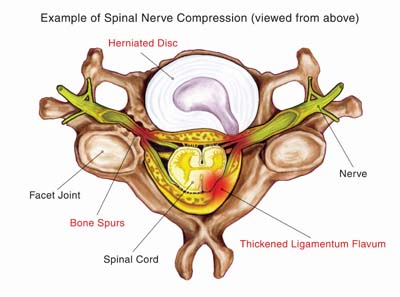Spinal stenosis is a condition caused by a gradual narrowing of the spinal canal and/or a reduction in the size of the bony openings where nerves exit and branch out from the spine. This narrowing happens as a result of degeneration of the anatomical structures in the spine, including the intervertebral discs, joints, and ligaments. In this condition, bone spurs, called osteophytes, which develop because of the excessive load on the intervertebral disc, grow into the spinal canal. The joints also enlarge as they become arthritic, which contributes to a decrease in the space available for the nerve roots. The ligaments of the spinal column, especially the ligamentum flavum, become stiff, less flexible, and thickened with age, also contributing to spinal stenosis. These processes narrow the spinal canal and may begin to impinge and put pressure on the nerves, roots, and spinal cord, creating the symptoms of spinal stenosis.

Spinal Stenosis results in different symptoms depending upon the region of the spine where it occurs. Spinal stenosis in the cervical (neck) or thoracic (upper back) spine can cause myelopathy (compression of the spinal cord) or radiculopathy (damage to the nerve roots). Lumbar spinal stenosis which occurs in the low back can result in neurogenic claudication (compression of the cauda equina) as well as radiculopathy.
Symptoms vary depending on the area of the spine affected. Numbness, weakness, or pain in the back and extremities is common. Spinal stenosis usually worsens over time; however, early diagnosis and treatment can slow or even halt its progression.
Symptoms
Cervical (neck) stenosis may cause:
- Neck pain ranging from mild to severe
- Pain, weakness, or numbness in the shoulders or extremities
- Impaired motor function, especially of the hands
- Alterations in gait or balance
Lumbar (lower back) stenosis may cause:
- Lower back pain ranging from mild to severe
- Pain, weakness, or numbness in the buttocks or legs
- Difficulty walking or standing for long periods; pain often relieved by sitting down or stooping forward
- Neurogenic claudication
- Foot disorders
Causes
- Osteoarthritis, degenerative changes in the discs and joints
- Spondylolisthesis
- Bone spurs
- Tumors
- Trauma to the spine
- Congenital conditions, including dwarfism
Although rare, severe stenosis can cause cauda equina syndrome. Symptoms may include loss of bowel or bladder control and/or pain, weakness, or loss of feeling in one or both legs. This is a medical emergency. If you experience any of these symptoms, it is important to be seen by a physician right away.
Treatment
The goal of treatment is to relieve pressure on the spinal cord or nerve roots, thus alleviating pain and restoring function. Conservative treatments, such as medication, steroid injections, or physical therapy, may be prescribed.
If conservative treatment fails, Dr. Stieber may recommend surgery for spinal stenosis to create additional space in the spine and prevent further damage to the spinal cord or nerves.
Decompressive laminectomy removes part of the vertebra to create space for the nerves. This surgery is sometimes combined with spinal fusion to stabilize the spine. In addition, new minimally-invasive procedures are available that may be appropriate to treat your condition. Dr. Stieber will work with you to develop a treatment plan best suited for your age, overall health, and lifestyle.
If you have been suffering from spinal stenosis and are considering surgery for spinal stenosis, please reach out to our office.
